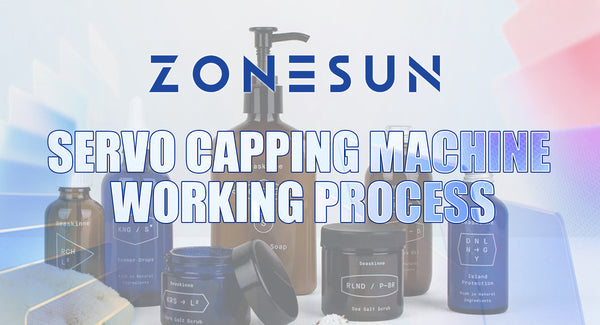
Exploring the Servo Capping Machine Working Process
In the realm of packaging and manufacturing, servo capping machines have emerged as a game-changer, streamlining and enhancing the process of applying caps to containers. These machines, powered by precise servo motors, offer a level of accuracy, efficiency, and versatility that traditional capping methods simply cannot match. Let's delve into the world of servo capping machines, exploring their intricacies and understanding their remarkable capabilities.
What‘s the capping Machines?
Servo Capping machines are specialized pieces of equipment designed to securely fasten caps onto containers, ensuring the integrity and preservation of products. They play a crucial role in various industries, ranging from pharmaceuticals and cosmetics to food and beverage. Capping machines come in a variety of configurations, each tailored to specific applications and production volumes.

ZS-XG440RSL Perameter
Machine model:ZS -XG440RSL
Voltage:AC 110/220V 50-60HZ
Machine power:About 2KW
Suitable cover diameter:30-80mm (Can be customized)
Working pressure:0.5-0.7Mpa
Working speed:About 20-60 bottles/min
Machine size:About 3200*2200* 1350mm
Delving into the Servo Capping Machine Mechanism
Servo capping machines stand out from their conventional counterparts by employing servo motors, which provide exceptional precision and control over the capping process. These motors, coupled with advanced control systems, enable the machine to apply the exact torque required for each cap, ensuring consistent and secure closure without damaging the container or product.

The servo capping machine's operation typically involves the following steps:
-
Cap Orientation and Feeding: Caps are fed into the machine, oriented correctly, and positioned for transfer to the capping head.
-
Container Gripping and Positioning: Containers are transported along the conveyor belt and securely gripped by the machine's gripper mechanism.
-
Cap Application: The servo-controlled capping head descends onto the container, precisely aligning the cap with the bottle opening.
-
Torque Application: The servo motor applies the pre-programmed torque, tightening the cap to the desired level.
-
Container Release and Inspection: The capped container is released from the gripper and moves along the conveyor for further processing or inspection.
Mastering the Art of Servo Capping Machine Operation

Operating a servo capping machine requires a combination of technical knowledge and hands-on training. Operators should be well-versed in the machine's specific functions, safety protocols, and maintenance procedures.
Here's a simplified overview of the operational steps:
-
Power Up and Initialization: Turn on the machine and allow it to initialize, ensuring all systems are functioning properly.
-
Parameter Settings: Input the necessary parameters, including cap type, container dimensions, and desired torque settings.
-
Cap Loading: Load the appropriate caps into the feeding system, ensuring they are properly oriented.
-
Container Conveyor Setup: Adjust the conveyor speed and positioning to match the production line's pace.
-
Production Monitoring: Continuously monitor the capping process, checking for any irregularities or malfunctions.
-
Regular Maintenance: Perform routine maintenance checks as per the manufacturer's guidelines to ensure optimal performance and machine longevity.
Unveiling the Operational Steps
Servo capping machines streamline the capping process by automating and precisely controlling each step. Here's a breakdown of the operational steps:
-
Cap Orientation and Feeding:
- Caps are fed into an orientation system, ensuring they are aligned correctly.
- A pick-and-place mechanism or a vibratory chute transfers the oriented caps to the capping head.
-
Container Gripping and Positioning:
- Containers move along a conveyor belt and are securely gripped by a gripper mechanism.
- The gripper positions the container precisely beneath the capping head.
-
Cap Application:
- The servo-controlled capping head descends onto the container, aligning the cap with the bottle opening.
- The servo motor applies the pre-programmed torque, tightening the cap to the desired level.
-
Container Release and Inspection:
- The gripper releases the capped container, which moves along the conveyor for further processing or inspection.
- Vision systems or sensors may inspect the cap for proper closure and alignment.
Servo capping machines have revolutionized the capping process, offering unparalleled precision, efficiency, and versatility. Their ability to handle a wide range of cap types and container sizes makes them an invaluable asset in various industries. By understanding the principles of servo capping machine operation, manufacturers can optimize their production processes and ensure the highest quality of their products.
